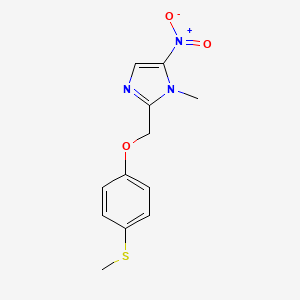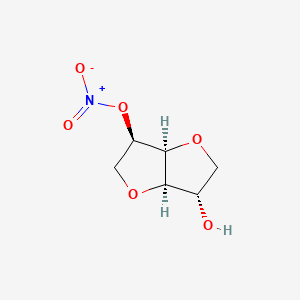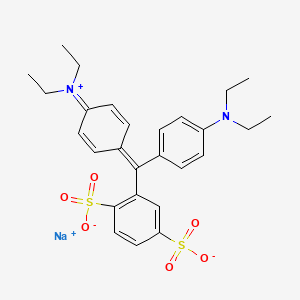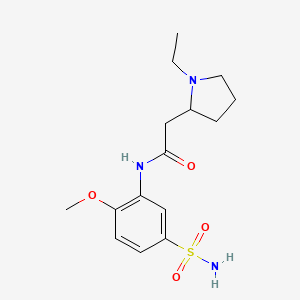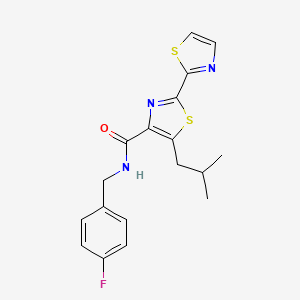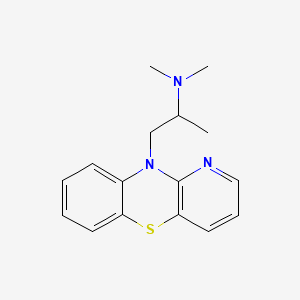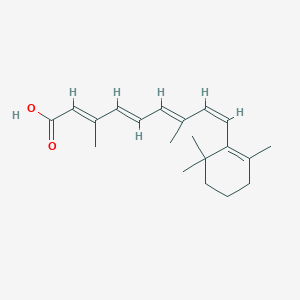
イトラコナゾール
概要
説明
Itraconazole is a triazole antifungal agent used to treat a variety of fungal infections, including aspergillosis, blastomycosis, coccidioidomycosis, histoplasmosis, and paracoccidioidomycosis . It was first synthesized in the early 1980s and approved for medical use in the United States in 1992 . Itraconazole is known for its broad-spectrum activity against fungal pathogens and is available in oral and intravenous formulations .
作用機序
Target of Action
Itraconazole primarily targets the fungal cytochrome P450 enzyme, lanosterol 14α-demethylase . This enzyme plays a crucial role in the conversion of lanosterol to ergosterol, a vital component of fungal cell membranes .
Mode of Action
Itraconazole exerts its antifungal activity by inhibiting the synthesis of ergosterol . It forms a complex with the active site, or the haem iron, of the fungal enzyme lanosterol 14α-demethylase . This inhibition blocks the conversion of lanosterol to ergosterol, disrupting the integrity of the fungal cell membrane, leading to leakage of essential cellular components, and ultimately inhibiting fungal growth and replication .
Biochemical Pathways
The inhibition of ergosterol synthesis leads to an accumulation of 14-methylsterol and depletion of ergosterol in fungal cells . This results in disruptions in membrane structure and function, affecting the stability and activity of many membrane-bound enzymes, and preventing fungal growth .
Pharmacokinetics
Itraconazole is extensively metabolized in the liver, primarily by the CYP3A4 enzyme . The major metabolite, hydroxy-itraconazole, reaches higher plasma concentrations than the parent compound and also has considerable antifungal activity . The bioavailability of itraconazole is approximately 55%, and it is maximal if taken with a full meal . The elimination half-life of itraconazole is about 21 hours , and it is excreted via the kidneys (35%) and feces (54%) .
Result of Action
The result of itraconazole’s action is the effective treatment of various fungal infections, including blastomycosis, histoplasmosis, and aspergillosis, in both immunocompromised and non-immunocompromised patients . It is also effective against onychomycosis of the toenail and fingernail due to dermatophytes, and for the treatment of oropharyngeal and esophageal candidiasis .
Action Environment
The action of itraconazole can be influenced by various environmental factors. For instance, the bioavailability of itraconazole is significantly increased when taken with food . Additionally, the drug’s efficacy can be affected by the patient’s immune status, with immunocompromised patients potentially requiring higher doses or longer treatment durations . Furthermore, the presence of other medications can influence itraconazole’s action due to potential drug-drug interactions, as itraconazole is known to inhibit the CYP3A4 enzyme, which is involved in the metabolism of many drugs .
科学的研究の応用
Itraconazole has a wide range of scientific research applications:
Chemistry: Itraconazole is studied for its unique chemical properties and interactions with various reagents.
Biology: It is used to investigate fungal cell biology and the mechanisms of antifungal resistance.
Medicine: Itraconazole is extensively used in clinical settings to treat fungal infections.
Industry: Itraconazole is used in the formulation of antifungal medications and topical treatments.
生化学分析
Biochemical Properties
Itraconazole mediates its antifungal activity by inhibiting 14α-demethylase, a fungal cytochrome P450 enzyme that converts lanosterol to ergosterol . Ergosterol is a vital component of fungal cell membranes. The azole nitrogen atoms in the chemical structure of itraconazole form a complex with the active site, or the haem iron, of the fungal enzyme to impede its function .
Cellular Effects
Itraconazole has been shown to inhibit the proliferation of certain cancer cells . It can regulate the G1-S transition and induce apoptosis of gastric cancer cells . In esophageal squamous cell carcinoma and adenocarcinoma cell lines, itraconazole inhibited cell proliferation and induced G1-phase cell-cycle arrest .
Molecular Mechanism
The mechanism of action of itraconazole is the same as the other azole antifungals: it inhibits the fungal-mediated synthesis of ergosterol, via inhibition of lanosterol 14α-demethylase . This results in the accumulation of lanosterol and 14-methylated sterols, leading to increased permeability of the fungal cell membrane, modified membrane-bound enzyme activity, and dysregulated chitin synthesis .
Temporal Effects in Laboratory Settings
In laboratory studies, itraconazole has shown a progressive increase in the probability of toxicity with increasing concentrations . The drug-induced changes of oxidative and peroxidative enzyme activities lead to toxic concentrations of hydrogen peroxide developing intracellularly .
Dosage Effects in Animal Models
In animal models, malformations and foetal resorptions were seen in overdose studies . High dosages (40 and 160 mg/kg bw/day for 10 days during their gestational period) have shown evidence of dose-related teratogenic, foetotoxic and maternotoxic effects .
Metabolic Pathways
Itraconazole is extensively metabolized by the liver, predominantly by the CYP3A4 isoenzyme system . It undergoes extensive hepatic metabolism into more than 30 metabolites, including hydroxy-itraconazole, which appears to have in vitro antifungal activity .
Transport and Distribution
Itraconazole is lipophilic and extensively distributed into tissues . Concentrations in the lung, kidney, liver, bone, stomach, spleen, and muscle were found to be two to three times higher than corresponding concentrations in plasma .
Subcellular Localization
It is known that itraconazole alters O-glycosylation and subcellular localization of CD44, a cell surface glycoprotein involved in cell-cell interactions, cell adhesion, and migration .
準備方法
Synthetic Routes and Reaction Conditions: The synthesis of itraconazole involves multiple steps, starting with the preparation of key intermediates. One common method includes the reaction of 1-(2,4-dichlorophenyl)-2-(1H-1,2,4-triazol-1-yl)ethanone with 1,3-dioxolane to form a dioxolane intermediate. This intermediate is then reacted with piperazine to yield itraconazole .
Industrial Production Methods: In industrial settings, itraconazole is prepared by dissolving a mixture of itraconazole and L-ascorbic acid in a mixed solvent of dichloromethane and methanol. Hydroxypropyl methylcellulose and pluronic F-127 are added, followed by dichloromethane to obtain a raw material solution. This solution is then subjected to supercritical fluid crystallization using carbon dioxide, resulting in composite particles with decreased particle size and increased bioavailability .
化学反応の分析
Types of Reactions: Itraconazole undergoes several types of chemical reactions, including oxidation, reduction, and substitution.
Common Reagents and Conditions:
Reduction: Specific reduction reactions of itraconazole are less common in the literature.
Substitution: Substitution reactions involving itraconazole typically occur during its synthesis rather than in its metabolic pathways.
Major Products Formed: The major metabolites of itraconazole include hydroxy-itraconazole, keto-itraconazole, and N-desalkyl-itraconazole .
類似化合物との比較
Itraconazole is often compared with other triazole antifungal agents such as fluconazole, voriconazole, and posaconazole:
Fluconazole: Itraconazole has a broader spectrum of activity, particularly against Aspergillus species, which fluconazole does not cover.
Voriconazole: Voriconazole has a broader spectrum of activity than itraconazole but is associated with more severe side effects.
Posaconazole: Posaconazole is similar to itraconazole in terms of spectrum but has better bioavailability and fewer drug interactions.
Itraconazole’s unique properties, such as its broad-spectrum activity and potential use in cancer treatment, make it a valuable compound in both clinical and research settings.
特性
CAS番号 |
84625-61-6 |
|---|---|
分子式 |
C35H38Cl2N8O4 |
分子量 |
705.6 g/mol |
IUPAC名 |
2-butan-2-yl-4-[4-[4-[4-[[(2R)-2-(2,4-dichlorophenyl)-2-(1,2,4-triazol-1-ylmethyl)-1,3-dioxolan-4-yl]methoxy]phenyl]piperazin-1-yl]phenyl]-1,2,4-triazol-3-one |
InChI |
InChI=1S/C35H38Cl2N8O4/c1-3-25(2)45-34(46)44(24-40-45)29-7-5-27(6-8-29)41-14-16-42(17-15-41)28-9-11-30(12-10-28)47-19-31-20-48-35(49-31,21-43-23-38-22-39-43)32-13-4-26(36)18-33(32)37/h4-13,18,22-25,31H,3,14-17,19-21H2,1-2H3/t25?,31?,35-/m0/s1 |
InChIキー |
VHVPQPYKVGDNFY-WSTHBRJPSA-N |
不純物 |
Impurities: 4-[4-[4-(4-methoxyphenyl)piperazin-1-yl]phenyl]-2-[(1RS)-1-methylpropyl]-2,4-dihydro-3H-1,2,4-triazol-3-one; 4-[4-[4-[4-[[cis-2-(2,4-dichlorophenyl)-2-(4H-1,2,4-triazol-4-ylmethyl)-1,3-dioxolan-4-yl]methoxy]phenyl]piperazin-1-yl]phenyl]-2-[(1RS)-1-methylpropyl]-2,4-dihydro-3H-1,2,4-triazol-3-one; 4-[4-[4-[4-[[cis-2-(2,4-dichlorophenyl)-2-(1H-1,2,4-triazol-1-ylmethyl)-1,3-dioxolan-4-yl]methoxy]phenyl]piperazin-1-yl]phenyl]-2-propyl-2,4-dihydro-3H-1,2,4-triazol-3-one; 4-[4-[4-[4-[[cis-2-(2,4-dichlorophenyl)-2-(1H-1,2,4-triazol-1-ylmethyl)-1,3-dioxolan-4-yl]methoxy]phenyl]piperazin-1-yl]phenyl]-2-(1-methylethyl)-2,4-dihydro-3H-1,2,4-triazol-3-one; 4-[4-[4-[4-[[trans-2-(2,4-dichlorophenyl)-2-(1H-1,2,4-triazol-1-ylmethyl)-1,3-dioxolan-4-yl]methoxy]phenyl]piperazin-1-yl]phenyl]-2-[(1RS)-1-methylpropyl]-2,4-dihydro-3H-1,2,4-triazol-3-one; 2-butyl-4-[4-[4-[4-[[cis-2-(2,4-dichlorophenyl)-2-(1H-1,2,4-triazol-1-ylmethyl)-1,3-dioxolan-4-yl]methoxy]phenyl]piperazin-1-yl]phenyl]-2,4-dihydro-3H-1,2,4-triazol-3-one; 4-[4-[4-[4-[[cis-2-(2,4-dichlorophenyl)-2-(1H-1,2,4-triazol-1-ylmethyl)-1,3-dioxolan-4-yl]methoxy]phenyl]piperazin-1-yl]phenyl]-2-[[cis-2-(2,4-dichlorophenyl)-2-(1H-1,2,4-triazol-1-ylmethyl)-1,3-dioxolan-4-yl]methyl]-2,4-dihydro-3H-1,2,4-triazol-3-one. |
SMILES |
CCC(C)N1C(=O)N(C=N1)C2=CC=C(C=C2)N3CCN(CC3)C4=CC=C(C=C4)OCC5COC(O5)(CN6C=NC=N6)C7=C(C=C(C=C7)Cl)Cl |
異性体SMILES |
CCC(C)N1C(=O)N(C=N1)C2=CC=C(C=C2)N3CCN(CC3)C4=CC=C(C=C4)OCC5CO[C@](O5)(CN6C=NC=N6)C7=C(C=C(C=C7)Cl)Cl |
正規SMILES |
CCC(C)N1C(=O)N(C=N1)C2=CC=C(C=C2)N3CCN(CC3)C4=CC=C(C=C4)OCC5COC(O5)(CN6C=NC=N6)C7=C(C=C(C=C7)Cl)Cl |
外観 |
Solid powder |
Color/Form |
Solid Crystals from toluene |
melting_point |
168-170 166.2 °C |
| 84625-61-6 84604-65-9 |
|
物理的記述 |
Solid |
ピクトグラム |
Irritant |
純度 |
>98% (or refer to the Certificate of Analysis) |
賞味期限 |
>2 years if stored properly |
溶解性 |
Practically insoluble in water and dilute acidic solutions |
保存方法 |
Dry, dark and at 0 - 4 C for short term (days to weeks) or -20 C for long term (months to years). |
同義語 |
Itraconazole, R51211, Orungal, Oriconazole, Sporanox, Itraconazolum, Itraconazol, Itrizole |
蒸気圧 |
2.6X10-20 mm Hg at 25 °C (est) |
製品の起源 |
United States |
Retrosynthesis Analysis
AI-Powered Synthesis Planning: Our tool employs the Template_relevance Pistachio, Template_relevance Bkms_metabolic, Template_relevance Pistachio_ringbreaker, Template_relevance Reaxys, Template_relevance Reaxys_biocatalysis model, leveraging a vast database of chemical reactions to predict feasible synthetic routes.
One-Step Synthesis Focus: Specifically designed for one-step synthesis, it provides concise and direct routes for your target compounds, streamlining the synthesis process.
Accurate Predictions: Utilizing the extensive PISTACHIO, BKMS_METABOLIC, PISTACHIO_RINGBREAKER, REAXYS, REAXYS_BIOCATALYSIS database, our tool offers high-accuracy predictions, reflecting the latest in chemical research and data.
Strategy Settings
| Precursor scoring | Relevance Heuristic |
|---|---|
| Min. plausibility | 0.01 |
| Model | Template_relevance |
| Template Set | Pistachio/Bkms_metabolic/Pistachio_ringbreaker/Reaxys/Reaxys_biocatalysis |
| Top-N result to add to graph | 6 |
Feasible Synthetic Routes
Q1: What is the primary mechanism of action of Itraconazole?
A1: Itraconazole exerts its antifungal activity by inhibiting the fungal cytochrome P450-dependent enzyme lanosterol 14α-demethylase. [] This enzyme plays a crucial role in the biosynthesis of ergosterol, a vital component of the fungal cell membrane. []
Q2: What are the downstream effects of inhibiting lanosterol 14α-demethylase?
A2: Inhibiting lanosterol 14α-demethylase disrupts ergosterol synthesis, leading to the accumulation of 14α-methylated sterol precursors within the fungal cell. [] This accumulation has several detrimental effects on the fungus:
- Membrane Integrity Disruption: The altered sterol composition compromises the integrity and fluidity of the fungal cell membrane. []
- Growth Inhibition: The inability to synthesize ergosterol ultimately inhibits fungal cell growth and replication. [, ]
Q3: What is the molecular formula and weight of Itraconazole?
A3: Itraconazole possesses the molecular formula C35H38Cl2N8O4 and a molecular weight of 705.64 g/mol.
Q4: Are there any specific spectroscopic data available for Itraconazole?
A4: While the provided research papers do not delve into detailed spectroscopic data, high-performance liquid chromatography (HPLC) coupled with various detection techniques like UV [] and fluorescence [] are commonly employed for Itraconazole analysis. Mass spectrometry (MS), particularly in tandem with HPLC (LC-MS/MS), is also frequently used for sensitive quantification. []
Q5: How does the formulation of Itraconazole affect its stability and bioavailability?
A5: Itraconazole exhibits variable bioavailability due to its low aqueous solubility. [] Studies have shown that administering Itraconazole with food can enhance its absorption and bioavailability. [] Developing formulations like nanoparticles [] and transethosomes [] can improve solubility and enhance delivery to target tissues.
Q6: How is Itraconazole metabolized in the body?
A6: Itraconazole undergoes extensive metabolism primarily in the liver by the cytochrome P450 enzyme, specifically CYP3A4. [, ] One major active metabolite is hydroxyitraconazole, often found in plasma at higher concentrations than the parent drug. [, ]
Q7: How does Itraconazole interact with other drugs that are also metabolized by CYP3A4?
A7: As a potent CYP3A4 inhibitor, Itraconazole can significantly affect the metabolism of co-administered drugs that rely on this enzyme. [, , ] This inhibition can lead to increased plasma concentrations of these drugs, potentially causing adverse effects or toxicity. [, , ] Some notable interactions include:
- Corticosteroids: Itraconazole can increase the levels of inhaled and oral corticosteroids, potentially leading to Cushing's syndrome or adrenal insufficiency. []
- Tacrolimus: Co-administration of Itraconazole can elevate tacrolimus concentrations, increasing the risk of nephrotoxicity. []
- Fexofenadine: Itraconazole can significantly increase the exposure to fexofenadine, even at lower doses. []
Q8: What is the significance of hydroxyitraconazole in the overall antifungal activity of Itraconazole?
A8: Hydroxyitraconazole, the major active metabolite, exhibits comparable antifungal activity to Itraconazole in vitro. [, ] Its presence in plasma at higher concentrations than the parent drug contributes significantly to the overall efficacy of Itraconazole treatment. []
Q9: How does Itraconazole compare with other antifungal agents in terms of efficacy against various fungal species?
A9: Itraconazole demonstrates a broad spectrum of activity against various fungal species:
- Aspergillus species: Effective against many Aspergillus species, but resistance has been observed. [, ] Combining Itraconazole with agents like domiphen may combat this resistance. []
- Sporothrix schenckii: Demonstrates efficacy in treating sporotrichosis, although relapse can occur. []
- Cryptococcus neoformans: Effective in inhibiting ergosterol synthesis and exhibits good activity against this species. []
- Dimorphic Fungi: Effective against both yeast and mycelial forms of dimorphic fungi. []
- Zygomycetes & Fusarium species: Generally less active against these fungal groups. [, ]
Q10: What in vivo models are used to study the efficacy of Itraconazole?
A10: Murine models are commonly employed to evaluate Itraconazole efficacy against systemic fungal infections like candidiasis and histoplasmosis. [, ] These models provide valuable insights into the drug's ability to reduce fungal burden and improve survival rates.
Q11: What are the mechanisms of resistance to Itraconazole?
A11: Resistance to Itraconazole can arise through several mechanisms:
- Efflux pump overexpression: Upregulation of drug efflux pumps can actively remove Itraconazole from the fungal cell, reducing its intracellular concentration. []
- Biofilm formation: Fungi within biofilms exhibit reduced susceptibility to antifungal agents, including Itraconazole. []
Q12: What are some strategies employed to enhance the delivery of Itraconazole to target tissues?
A12: Due to its low aqueous solubility, researchers are exploring different drug delivery strategies:
- Nanoparticles: Encapsulating Itraconazole within nanoparticles can improve its solubility and bioavailability, allowing for targeted delivery to specific tissues. []
- Transethosomes: These specialized vesicles can enhance transdermal delivery of Itraconazole, enabling localized treatment of skin infections. []
- Salt Formation & Complexation: Converting Itraconazole into salts and forming inclusion complexes with cyclodextrins like sulfobutyl ether7 β-cyclodextrin (Captisol) can enhance its solubility and dissolution rate. []
Q13: What analytical methods are commonly used to quantify Itraconazole and its metabolites in biological samples?
A13: Several techniques are utilized for Itraconazole quantification:
- High-Performance Liquid Chromatography (HPLC): HPLC, coupled with UV [] or fluorescence detection [], is frequently employed for sensitive and specific analysis of Itraconazole in biological matrices.
- Liquid Chromatography-Mass Spectrometry (LC-MS/MS): This highly sensitive and specific technique allows for simultaneous quantification of Itraconazole and its metabolites, even at low concentrations. []
- Bioassay: While less common, bioassays can be used to assess the overall antifungal activity of serum samples from Itraconazole-treated individuals. []
試験管内研究製品の免責事項と情報
BenchChemで提示されるすべての記事および製品情報は、情報提供を目的としています。BenchChemで購入可能な製品は、生体外研究のために特別に設計されています。生体外研究は、ラテン語の "in glass" に由来し、生物体の外で行われる実験を指します。これらの製品は医薬品または薬として分類されておらず、FDAから任何の医療状態、病気、または疾患の予防、治療、または治癒のために承認されていません。これらの製品を人間または動物に体内に導入する形態は、法律により厳格に禁止されています。これらのガイドラインに従うことは、研究と実験において法的および倫理的な基準の遵守を確実にするために重要です。


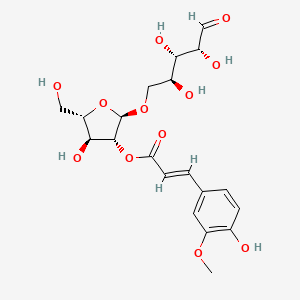
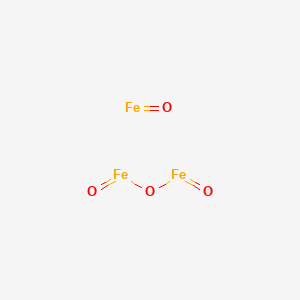

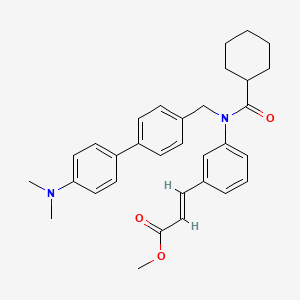
![(E)-Methyl 3-(3-(N-(4-(benzo[d][1,3]dioxol-5-yl)benzyl)cyclohexanecarboxamido)phenyl)acrylate](/img/structure/B1672615.png)
